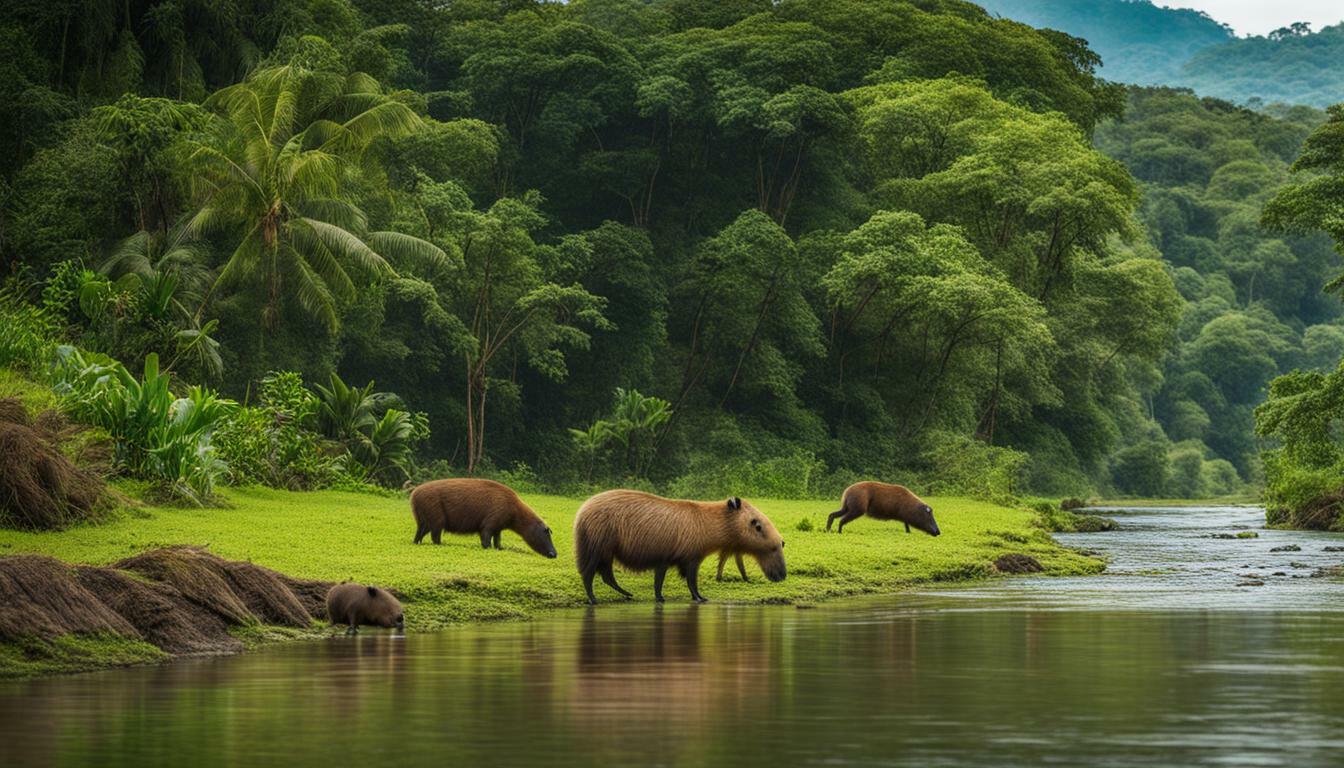Costa Rica is known for its diverse fauna, but are there capybaras in this Central American country? Although capybaras are not native to Costa Rica, they have managed to establish small populations in certain wetland areas and along riverbanks. These unique creatures have adapted to a semi-aquatic lifestyle, equipped with webbed feet for swimming and maneuvering in the water. As herbivores, they primarily consume plants and graze on grasses, aquatic plants, and tree bark.
Capybaras are highly social animals, living in groups and relying on social interactions for their survival. Their presence in Costa Rica plays a crucial role in the ecosystem. They influence vegetation growth and serve as a source of prey for predators, contributing to the delicate balance of the country’s wildlife.
While capybaras are not widespread in Costa Rica due to climate and predation factors, conservation efforts are actively underway to protect them and their habitats. For those interested in spotting these fascinating creatures, it is recommended to visit national parks and protected areas with wetland habitats. The early morning and late afternoon are the best times to catch them in action, as they are most active during these hours.
Key Takeaways:
- Capybaras are not native to Costa Rica but have established small populations in certain wetland areas and along riverbanks.
- They have adapted to a semi-aquatic lifestyle with webbed feet for swimming and maneuvering in the water.
- Capybaras are herbivores, primarily consuming plants and grazing on grasses, aquatic plants, and tree bark.
- They are highly social animals, living in groups and relying on social interactions for their survival.
- Capybaras play a crucial role in Costa Rica’s ecosystem by influencing vegetation growth and serving as a source of prey for predators.
Capybara Sightings in Costa Rica
In recent years, there have been increasing reports of capybara sightings in certain regions of Costa Rica. While capybaras are not native to the country, they have managed to establish small populations in specific wetland areas and along riverbanks. This adaptation to the country’s semi-aquatic environments has allowed capybaras to thrive and be observed by locals and tourists.
Capybaras, known for their webbed feet that enable them to swim and maneuver in the water, have become a fascinating sight for nature enthusiasts in Costa Rica. The sightings of these remarkable creatures have sparked interest in their presence and behavior, prompting further research and conservation efforts.
These sightings have shed light on the behavior and characteristics of capybaras in Costa Rica. They are highly social animals, living in groups that can range from a few individuals to large gatherings. Their group living habits help them navigate their environment and provide protection against potential predators.
Considering the growing number of capybara sightings, it is evident that these animals are becoming more prevalent in certain regions of Costa Rica. This serves as a testament to the adaptability and resilience of capybaras, as they carve out a place for themselves in the country’s diverse ecosystems.
| Key Facts about Capybara Sightings in Costa Rica |
|---|
| Capybaras have established small populations in wetland areas and along riverbanks in Costa Rica. |
| They are highly adaptable to the country’s semi-aquatic environments. |
| Capybaras are social animals, living in groups. |
| Their presence in certain regions of Costa Rica has attracted attention from nature enthusiasts and researchers. |
| Conservation efforts are underway to protect capybaras and their habitats. |
Capybara Habitat in Costa Rica
Capybaras in Costa Rica have found their niche in wetland areas and along riverbanks, making these habitats their home. They have adapted to a semi-aquatic lifestyle, equipped with webbed feet that facilitate swimming and maneuvering in the water. These unique features allow capybaras to thrive in the diverse ecosystems of Costa Rica, where they play an important role as wildlife.
Their preference for wetland areas and riverbanks is driven by the abundance of vegetation and access to water sources. Capybaras are herbivores, feeding on a diet primarily composed of plants. They graze on grasses, aquatic plants, and even consume tree bark. This selective feeding behavior contributes to the balance of the local ecosystem, as capybaras help regulate plant growth and prevent overpopulation of certain species.
Not only are capybaras well-adapted to their chosen habitat, but they also exhibit highly social behavior. They live in groups, forming close-knit communities that rely on social interactions for survival. These interactions contribute to their overall well-being and serve as a defense mechanism against predators. Capybaras are a vital part of Costa Rica’s wildlife diversity and have become a symbol of the country’s rich ecological heritage.
| Capybara Habitat Characteristics | Preferred Locations |
|---|---|
| Semi-aquatic environment | Wetland areas |
| Abundance of vegetation | Riverbanks |
| Access to water sources |
Given their adaptability and importance as wildlife, capybaras are a treasured asset to Costa Rica’s ecosystem. While their presence is limited due to climate and predation factors, conservation efforts are underway to protect them and their habitats. To catch a glimpse of these fascinating creatures, visit national parks and protected areas in Costa Rica known for their wetland habitats. Dawn and dusk, during the early morning and late afternoon, are the best times to increase your chances of spotting capybaras in their natural habitat.
Capybaras: Social Animals of Costa Rica
Capybaras are highly social animals, and their behavior in Costa Rica reflects their reliance on social interactions for their well-being. These charismatic rodents form close-knit groups known as harems, consisting of one dominant male, multiple females, and their offspring. Living in these cohesive units helps capybaras navigate the challenges of their environment and enhances their chances of survival.
In their social interactions, capybaras engage in a variety of behaviors that promote cohesion and communication within the group. They often engage in mutual grooming sessions, where they take turns grooming each other’s fur, fostering social bonds and reinforcing their social hierarchy. This behavior also serves practical purposes, as grooming helps maintain their hygiene and remove parasites.
Another fascinating aspect of capybara social life is their vocalizations. These large rodents communicate through an array of sounds, including barks, whistles, chirps, and even purrs. These vocalizations play a crucial role in expressing emotions, identifying individuals, and signaling potential threats to the group.
While capybaras are known for their social nature, they also display a remarkable tolerance towards other species. They often share their habitat with a diverse array of animals, such as birds, reptiles, and other mammals. This coexistence highlights the important role capybaras play in the ecosystem of Costa Rica and their status as a keystone species. Their grazing habits help shape vegetation growth, contributing to the balance of the local ecosystem.
Overall, capybaras in Costa Rica exemplify the significance of social interactions in their lives. Their cohesive groups and complex communication demonstrate the value they place on cooperation and mutual support. Observing these fascinating creatures in their natural habitat provides a unique opportunity to witness the intricate dynamics of their social behavior.
Capybaras: Herbivores of Costa Rica
As herbivores, capybaras in Costa Rica sustain themselves by consuming various plants found in their habitat. These gentle giant rodents have a diverse diet that consists primarily of vegetation such as grasses, aquatic plants, and tree bark. With their sharp teeth and powerful jaws, capybaras are well-equipped to graze on and digest a wide range of plant material.
One of the key adaptations of capybaras is their ability to thrive in wetland areas and semi-aquatic environments. Their webbed feet enable them to easily navigate through marshes, rivers, and swamps in search of the lush vegetation they depend on. This habitat preference further contributes to their herbivorous lifestyle as they have easy access to a variety of aquatic plants and grasses.
Capybaras play a vital role in the ecosystem of Costa Rica. They act as herbivorous keystone species, meaning their feeding habits have a significant impact on the vegetation growth and structure of their habitat. By consuming various plants, capybaras help promote the regeneration of vegetation, maintain plant diversity, and create open spaces for other species to thrive.
| Diet of Capybaras in Costa Rica | Preferred Food Sources |
|---|---|
| Grasses | Wide variety of grass species found along riverbanks and wetland areas |
| Aquatic plants | Water lilies, water hyacinths, and other aquatic vegetation |
| Tree bark | Bark from trees such as willows and other species commonly found in their habitat |
In addition to their ecological importance, capybaras in Costa Rica are also an attraction for wildlife enthusiasts. While their presence is limited due to climate and predation factors, visitors can increase their chances of spotting these fascinating creatures by visiting national parks and protected areas known for their wetland habitats. It is recommended to plan visits during the active hours of capybaras, which are typically early morning and late afternoon when they are more likely to be feeding and active.
Conservation efforts are underway in Costa Rica to protect capybaras and their habitats. As these unique animals continue to face various challenges, including habitat loss and human-wildlife conflict, it is crucial to support initiatives that preserve their populations and ensure their long-term survival in the country.
Capybaras and Costa Rica’s Ecosystem
Capybaras play a crucial role in Costa Rica’s ecosystem by influencing vegetation growth and serving as an important food source for predators. These semi-aquatic creatures have established small populations in certain wetland areas and along riverbanks, where they have adapted to their unique environment. With their webbed feet, capybaras are well-equipped for swimming and maneuvering through the water, allowing them to thrive in their chosen habitats.
As herbivores, capybaras primarily consume plants and have a varied diet that includes grazing on grasses, aquatic plants, and tree bark. Their feeding habits contribute to the shaping of local vegetation and the maintenance of critical wetland ecosystems. Additionally, their consumption of plant matter helps control vegetation growth, preventing overgrowth and allowing other species to thrive in their shared habitats.
But capybaras are not just important for vegetation management. They are highly social animals that live in groups, relying on social interactions for survival and support. Their group living habits foster cooperation and protection against predators. Furthermore, capybaras act as an essential source of prey for other wildlife in Costa Rica. Predators such as crocodiles, jaguars, and large birds of prey rely on capybaras for sustenance, maintaining a delicate balance in the ecosystem.
While the presence of capybaras in Costa Rica is limited due to climate conditions and predation, conservation efforts are underway to protect these fascinating creatures and their habitats. Visitors who want to spot capybaras in their natural environment are encouraged to explore national parks and protected areas with wetland habitats, as these areas offer the highest chances of encountering these unique animals. It is recommended to plan visits during the active hours of capybaras, which are early morning and late afternoon, when they are more likely to be active and visible to observers.
| Key Points |
|---|
| Capybaras influence vegetation growth in Costa Rica |
| They serve as an important food source for predators |
| Capybaras are herbivores, consuming plants and grazing on grasses, aquatic plants, and tree bark |
| They live in social groups and rely on social interactions for survival |
| Conservation efforts are underway to protect capybaras and their habitats |
Conservation Efforts for Costa Rican Capybaras
Recognizing the importance of capybaras in Costa Rica, conservation initiatives have been put in place to safeguard their populations and habitats. These efforts aim to protect the unique ecological role of capybaras and ensure their survival in the country. One such initiative is the establishment of protected areas and national parks that provide suitable habitats for capybaras to thrive.
These protected areas serve as sanctuaries for capybaras and other wildlife, preserving their natural habitats and biodiversity. One example is the Tortuguero National Park, located on the Caribbean coast of Costa Rica. This park encompasses a vast expanse of wetlands, which are ideal habitats for capybaras. Visitors to Tortuguero have the opportunity to observe these fascinating creatures in their natural environment.
In addition to protected areas, conservation organizations and research institutions in Costa Rica are actively studying capybaras to gain a better understanding of their behavior, population dynamics, and habitat needs. This research helps inform conservation strategies and management plans to ensure the long-term survival of capybaras in the country.
Conservation Efforts Highlight:
- Establishment of protected areas and national parks
- Research and monitoring of capybara populations
- Collaboration with local communities for conservation education
“Capybaras are a vital part of Costa Rica’s ecosystems, and protecting their populations is crucial for maintaining the balance of wildlife and habitat conservation.” – Dr. Maria Rodriguez, Wildlife Conservationist
Conservation efforts for capybaras in Costa Rica also involve raising awareness among local communities and visitors about the importance of these unique animals. By promoting responsible tourism and providing education on capybara conservation, there is a greater chance of preserving their habitats and minimizing human-wildlife conflicts.
Table: Costa Rican National Parks with Capybara Habitats
| National Park | Location | Capybara Sightings |
|---|---|---|
| Tortuguero National Park | Caribbean coast | Frequent |
| Caño Negro Wildlife Refuge | North-central region | Occasional |
| Palo Verde National Park | Northwestern region | Rare |
While capybara populations in Costa Rica may be limited compared to their native habitats, the ongoing conservation efforts demonstrate the commitment to protect these remarkable creatures and their contributions to the country’s ecosystems. By implementing effective conservation strategies and promoting sustainable practices, it is possible to ensure the survival of capybaras in Costa Rica for generations to come.
Spotting Capybaras in Costa Rica
If you’re eager to catch a glimpse of capybaras in Costa Rica, visit national parks and protected areas that offer suitable wetland habitats for these fascinating creatures. These locations provide the ideal environment for capybaras to thrive, as they are semi-aquatic animals that rely on wetlands and riverbanks for their survival.
One such park is Tortuguero National Park, located on the northeastern coast of Costa Rica. This biodiverse park is home to a variety of wildlife, including capybaras. The park’s extensive network of canals, lagoons, and marshes makes it an excellent spot to observe these captivating animals in their natural habitat.
Another recommended destination is Palo Verde National Park, situated in the Guanacaste Province. This park is renowned for its wetlands and is a haven for birdwatchers and nature enthusiasts. While exploring the park’s trails and boat tours, keep an eye out for capybaras along the riverbanks and in the surrounding grassy areas.
During your visit, remember that capybaras are most active during the early morning and late afternoon. These are the best times to increase your chances of spotting them as they forage for food and engage in social interactions with other members of their group. Keep a safe distance and observe them quietly to avoid disturbing their natural behavior.
| National Park | Location |
|---|---|
| Tortuguero National Park | Northeastern coast of Costa Rica |
| Palo Verde National Park | Guanacaste Province |
So, plan your visit to one of these national parks and protected areas in Costa Rica to witness the remarkable sight of capybaras in their natural habitat. Marvel at their ability to adapt to a semi-aquatic lifestyle, observe their herbivorous feeding habits, and appreciate their importance within Costa Rica’s rich ecosystem.
Active Hours of Costa Rican Capybaras
To maximize your chances of seeing capybaras in Costa Rica, plan your visits during their active hours in the early morning and late afternoon. These periods are when capybaras are most active and likely to be seen in their natural habitats. Being crepuscular animals, capybaras are most active during sunrise and sunset, venturing out from their hiding spots to forage for food or socialize with their group.
During these active hours, capybaras can be observed engaging in a variety of behaviors, such as grazing on grasses, munching on aquatic plants, or playfully interacting with their companions. By visiting Costa Rican national parks or protected areas with wetland habitats, you increase your chances of encountering capybaras in their natural environment.
When exploring the wetlands and riverbanks where capybaras commonly reside, keep in mind that they are semiaquatic creatures. Their webbed feet enable them to swim and navigate through water effortlessly, making it easier for them to move between different areas within their habitat. Observing capybaras near bodies of water, whether it be a river or a pond, can offer incredible opportunities to witness their aquatic abilities and unique behaviors.
It’s important to remember that capybaras, although not native to Costa Rica, have adapted to specific wetland areas and riverbanks in the country. Their population is relatively small and limited due to various factors, including climate and predation. However, ongoing conservation efforts strive to protect these fascinating animals and their habitats, ensuring their survival and continued presence in Costa Rica.
| Scientific Name | Habitat | Active Hours |
|---|---|---|
| Hydrochoerus hydrochaeris | Wetland areas, riverbanks | Early morning, late afternoon |
Conclusion
While capybaras are not native to Costa Rica, their small populations have established themselves in certain wetland areas and along riverbanks, playing a significant role in the country’s ecosystem. Conservation efforts are vital to ensure their continued survival and the preservation of their habitats.
Capybaras have adapted to a semi-aquatic lifestyle with webbed feet for swimming and maneuvering in the water. As herbivores, they primarily consume plants and graze on grasses, aquatic plants, and tree bark. Their highly social nature prompts them to live in groups, relying on social interactions for survival.
These unique animals play a crucial role in Costa Rica’s ecosystem. They influence vegetation growth and serve as a source of prey for predators. However, their presence remains limited due to climate and predation factors. To increase the likelihood of spotting capybaras, it is recommended to visit national parks and protected areas with wetland habitats, especially during their active hours in the early morning and late afternoon.
Conservation efforts are underway in Costa Rica to protect capybaras and their habitats. By promoting awareness and implementing measures to safeguard these remarkable creatures, authorities and organizations aim to ensure their long-term survival and contribute to the overall preservation of the country’s biodiversity.
FAQ
Are capybaras native to Costa Rica?
No, capybaras are not native to Costa Rica, but they have established small populations in certain wetland areas and along riverbanks.
What is the diet of capybaras in Costa Rica?
Capybaras in Costa Rica are herbivores, consuming mostly plants and grazing on grasses, aquatic plants, and tree bark.
Do capybaras live in groups?
Yes, capybaras are highly social animals and live in groups, relying on social interactions for survival.
What role do capybaras play in Costa Rica’s ecosystem?
Capybaras play a crucial role in Costa Rica’s ecosystem by influencing vegetation growth and serving as a source of prey for predators.
What conservation efforts are being made to protect capybaras in Costa Rica?
Conservation efforts are underway in Costa Rica to protect capybaras and their habitats.
Where can I spot capybaras in Costa Rica?
To increase your chances of spotting capybaras in Costa Rica, it is recommended to visit national parks and protected areas with wetland habitats.
What are the active hours of capybaras in Costa Rica?
Capybaras in Costa Rica are most active during the early morning and late afternoon.




